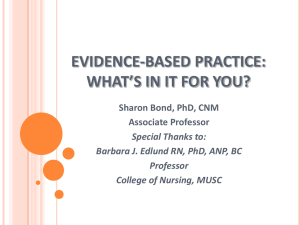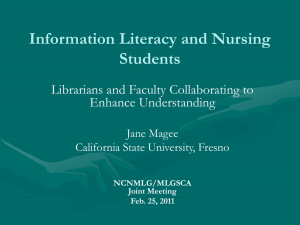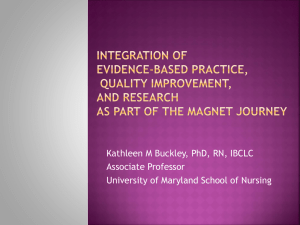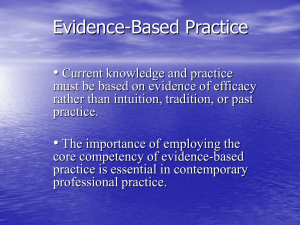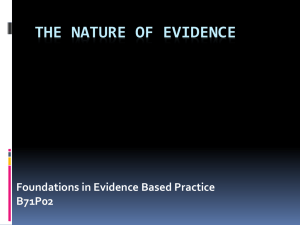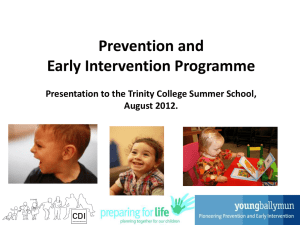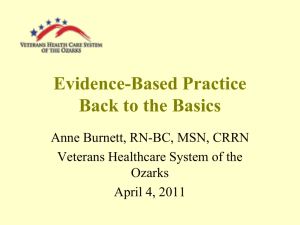Evidence Based Practice - American Nephrology Nurses Association
advertisement
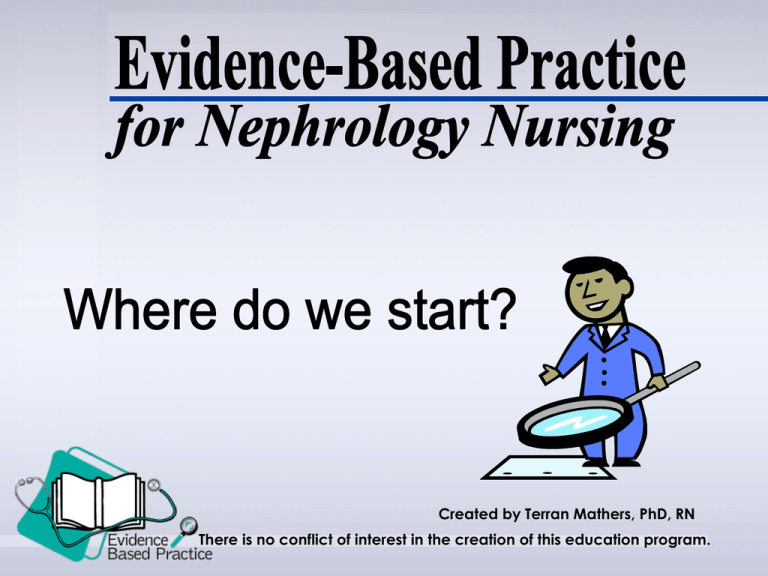
Created by Terran Mathers, PhD, RN There is no conflict of interest in the creation of this education program. Objectives Explain the importance of Evidence Based Practice (EBP) in nephrology nursing. List the steps of EBP. Identify four internet resources/databases where previous research or guidelines may be located. Recognize potential barriers to EBP within an organization so that strategies may be planned to overcome them. Introduction Historical Background of EBP 1837: Pierre Louis 1970’s: Cochran Collaboration 1972: Briggs Report (DHSS) 2004: ANNA Nursing Research Committee Survey What is Evidence-Based Research? EBR defined: Clinically relevant research based on medical science; this research is patient-centered. Research Utilization: Use of the knowledge found from research, usually based on a single study. Cochrane Center (meta-analysis reviews) (Melnyk & Fineout-Overholt, 2005; Sackett et al, 2000) What Is Evidence-Based Practice? Assessment Clinical Experience And Expertise Search and Appraisal Of Evidence Patient Preferences & Values Evidence Based Practice ** Clinical Decision Making Sackett et al, 2000; Melnyk & Fineout-Overholt, 2005 Why Evidence-Based Practice? Quality Care Cost Containment Positive Patient Outcomes Enhance Professional Environment Centers for Evidence-Based Practice www.ahrq.gov/clinic/epc/epcenters.htm Blue Cross and Blue Shield Association Duke University ECRI John Hopkins University McMaster University Oregon Health & Science University RTI International – University of North Carolina Southern California Stanford University – University of California, San Francisco Tufts University – New England Medical Center University of Alberta, Edmonton, Alberta, Canada University of Minnesota, Minneapolis, MN University of Ottawa, Ottawa, Canada Steps of Evidence-Based Practice Step 1: What is the clinical question? Melnyk & Fineout-Overholt, 2005 Ask the clinical question in the “PICO” format P= I = C= O= Patient Population / Disorder Intervention or Interest Area Comparison Outcome PICO Example: P = Elderly nephrology patients I = Psychosocial issues C = Effect on compliance O = Patient will be able to adapt to changes related to diagnosis and treatment Steps of Evidenced-Based Practice Step 2: Find the best evidence to answer the question Systematic review of the literature Meta-analysis or clinical practice guidelines Rigorous process Preset criteria Overcomes bias Valid / credible results Guideline Databases National Guideline Clearinghouse (NGC) http://www.guideline.gov National Institute for Clinical Excellence (NICE) http://www.nice.org.uk/catcg2.asp?c=20034 National Kidney Foundation K/DOQI Guidelines: http://www.kidney.org/professionals/doqi/guidelineindex.cfm Steps of Evidence-Based Practice Step 3: Appraise the evidence Critical Questions to Ask: 1. What were the results of the study? 2. Are the results valid? 3. Will the results facilitate patient care? Steps of Evidence-Based Practice Step 4: Integrate the evidence, patient assessment information, clinical expertise, patient preferences and values. Steps of Evidence-Based Practice Step 5: Evaluate the change in the clinical area. Implementing EBP: The Barriers Translating the meaning and relevance of EBP Knowledge deficit Being overwhelmed by the evidence The need for dedicated time Negative views about research Organizational constraints VanBuskirk, 2005; Melnyk & Fineout-Overholt, 2005 Facilitation of EBP Promote Acceptance Access with surveys; focus groups Identify baseline knowledge Identify real case scenarios Analyze the culture of the environment Facilitation of EBP Correct Misperceptions Have key leaders attend nursing centers Teach the basics of EBP (Online Tutorials) Expose to useful databases EBP Online Tutorials Evidence-Based Clinical Practice Tutorial http://www.urmc.rochester.edu/hslt/miner/digital_library/eviden ce_based_resources.cfm Texas Health Science Center: Academic Center for Evidence-Based Nursing http://www.acestar.uthscsa.edu/ Evidence-Based Nursing http://www.hsl.unc.edu/Services/Tutorials/EBN/index.htm Facilitation of EBP Question Clinical Practices Prioritize problems Utilize clinical practice guidelines and research Promote a culture of organizational acceptance for EBP References Honor Society of Nursing, Sigma Theta Tau International (2005). Honor Society of Nursing, Sigma Theta Tau International: Position statement on evidence-based nursing. Indianapolis: Sigma Theta Tau International. Cowan, P. (2004). Advancing evidence-based practice through meta-analysis. Nephrology Nursing Journal, 31(3), 343-345. Gagan, M., & Hewitt-Taylor, J. (2004). The issues for nurses involved in implementing evidence in practice. British Journal of Nursing, 13(20), 1216-1220. References Gillis, A., & Jackson, W. (2002). Research for nurses: Methods and interpretation. Philadelphia: F.A. Davis. Larrabee, J. (2004). Advancing quality improvement through using the best evidence to change practice. Journal of Nursing Care Quality, 19(1). 10-14. Malloch, K., & Porter-O’Grady, T. (2006). Introduction to evidence-based practice in nursing and health care. Boston: Jones and Bartlett. Melnyk, B. M., & Fineout-Overholt, E. (2005). Evidence-based practice in nursing and healthcare: A guide to best practice. Philadelphia: Lippincott, Williams, & Wilkins. References Pape, T. (2003). Evidence-based nursing practice: To infinity and beyond. The Journal of Continuing Education in Nursing, 34(4), 154-164. Paramonczyk, A. (2005). Barriers to implementing research in clinical practice. The Canadian Nurse, 101(3), 12-18. Portney, L. (2004). Evidence-based practice and clinical decision making: It’s not just the research course anymore. Journal of Physical Therapy Education, 18(3), 46-51. References Tod, A., Palfreyman, S., & Burke, L. (2004). Evidencebased practice is a time of opportunity for nursing. British Journal of Nursing, 13(4), 211-216. VanBuskirk, S. (2005). The value of evidence-based practice in nephrology nursing. Nephrology Nursing Journal, 32(2), 134-135. Sackett, D. L., Straus, S. E., Richardson, W. S. et al. (2000). Evidence-based medicine: how to practice and teach EBM. London: Churchill, Livingstone.
